| Amis, Kingsley, THE JAMES BOND DOSSIER, 1, 1965, Jonathan Cape, Ltd (London), HB. The British edition of Amis's study of James Bond slyly evokes the Scarlet Pimpernel. See 1966 entry. |
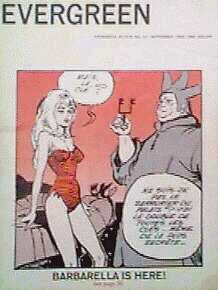 |
BARBARELLA, Comic Strip, 1, 1965, Writer/Illustrator: Jean Claude Forest. Featured in THE EVERGREEN REVIEW ( Number 37:September 1965) . BARBARELLA was America's first look at a sexy European comic strip. Forest created her in a French magazine (heh,heh). The book version got banned by the authorities. It made its way to the U.S. by way of THE EVERGREEN REVIEW, a publication of battling Grove Press. Grove published books that seemed to always get banned somewhere. Today, its all very tame, even for comic books--just sex and science fiction in decadent style. It's probably better remembered for Roger Vadim's movie version (see 1968 entry), with Jane Fonda stripping while weightless. BARBARELLA sparked lots of European imitations, none of which ever made it big in the states. One homegrown strip PHOEBE ZEIT-GEIST was to have some far-reaching success (see 1966 entry). The success of these early "adult" comic strips and graphic novels (as they were later called) helped spawn the "underground comix" of the late 60s and 70s. |
Barton, Pierre, COMFORTABLE PEW, THE. 1965, Lippincott, Trade. HB?
Boyd, Malcolm, ARE YOU RUNNING WITH ME, JESUS, 1, 1965, Holt, Rinehart and Winston, HB. See 1967 entry.
Burgess, Anthony, CLOCKWORK ORANGE, A, 2, 1965, Ballantine, PB. entry
Camp, L. Sprague de, ARROWS OF HERCULES, 1, 1965, Doubleday, HB. See
1970 entry.
| Capote, Truman, IN COLD BLOOD, 1, 1965, Random House, HB. |
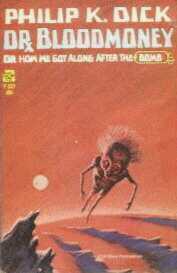 |
Dick, Philip K., DR BLOODMONEY, OR HOW WE GOT ALONG AFTER THE BOMB, 1, 1965, Ace Books, PB. |
Evans, Bergen, NATURAL HISTORY OF NONSENSE, THE, 1965, Alfred A. Knopf,
HB.
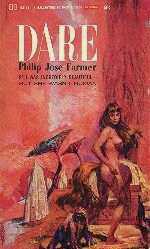 |
Philip Jose Farmer, DARE, 1, 1965, Ballantine, PB. Another of Farmer's novels on the theme of alien sex. |
FOR A FEW DOLLARS MORE, Motion Picture, 1965 Director: Sergio Leone,
Italian release date. See 1967 entry.
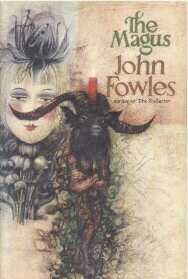 |
Fowles, John, MAGUS, THE, 1, 1965, Little Brown, HB. A selfish young Englishman in the Aegean becomes involved in the strange goings on at the house of a local mystery man. Each visit is more intense and begins to resemble a kind of psycho-theatre. The title is from the 9th Tarot trump, and Tarot imagery abounds throughout. There is a long but little known tradition of using the Tarot deck as a compositional device in fiction and poetry. The clue that Fowles is doing this is that there are 78 chapters, just as there are 78 cards in the Tarot deck. Few critics ever notice this. This was Fowles' first novel, but his second published novel. He wrote THE COLLECTOR to prove to his publishers that THE MAGUS wasn't a fluke. Like V. by Pynchon, THE MAGUS had a long, steady popularity throughout the 60's and 70's. |
Gaddis, Vincent, INVISIBLE HORIZONS, 1, 1965, Chilton, HB. Also Ace, PB, no date. Ever wake up late at night, in a cold sweat, wondering just how and who started the Bermuda Triangle thing? Go back to bed and sleep soundly, this is the book.
Gardner, Martin, RELATIVITY FOR THE MILLION, 2, 1965, Pocket Books, PB, entry
Gettings, Fred, BOOK OF THE HAND, THE, 1965, Peter Hamlyn (London), HB.
Graves, Robert, and Patai, Raphael, HEBREW MYTHS, 1, 1965, Doubleday, HB.
Hall, Adam (Elleston Trevor), QUILLER MEMORANDUM, THE, 1 1965, Simon
and Schuster, HB. This was the first appearance of Quiller, the non-linear
spy. Quiller is an intelligence operative who makes his way through the
world of intrigue using instinct and "feel". In the first few novels he
uses the personal feedback system from Maltz's PSYCHO-CYBERNETICS. Later
on Hall would add Zen, Taoism, and various martial arts to Quiller's training.
This inner discipline gives him a bizarre personal passivity coupled with
a personal awareness that seems almost psychic (Playwright Harold Pinter
was able to do wonderful things with him in the 1966 film version of this
novel). Quiller is one of the first of many "spiritual warriors" who would
appear in fiction in the next few years.
 |
Hawkins, Gerald, with White, John B., STONEHENGE DECODED, 1965, Doubleday, HB (See 1966 entry). It's safe to say that before this book, there was no such discipline as Astroarchaeology. Hawkins used a computer to prove what Sir Norman Lockyer had postulated at the turn of the century: ancient European megalithic sites were built upon astronomical models. This led to a whole new view of ancient technological knowledge. Hawkins' ideas appeared in NATURE, 1963, and were already known from newspaper coverage. A CBS T.V. special, MYSTERY OF STONEHENGE, also aired before the publication of the book. This publicity probably made STONEHENGE DECODED a great success. Hawkins owed much to Alexander Thom (See 1967 and 1971 entries). |
 |
Herbert, Frank, DUNE, 1, 1965, Chilton, HB. DUNE is one of those well-known paperback success stories. Parts of the massive novel had appeared in science fiction magazines with moderate success. The hardback was only a moderate success, too. Then Ace published it in paper, and it was a big seller. There will be no entry for the Ace edition because Ace always obscures its publication dates. Why do they do that? DUNE is justly famous for its total creation of an ecology, political systems, religions, and a cosmic long view of history. What's so fascinating is how Herbert borrowed so much from Earth's history (especially the Byzantine Empire and the rise of Islam) and made it seem as though we'd never heard it before. |
Hesse, Hermann, DEMIAN, 1, 1965, Harper and Row, HB (and trade?). Translation
of 1919 German title. See 1966 entry.
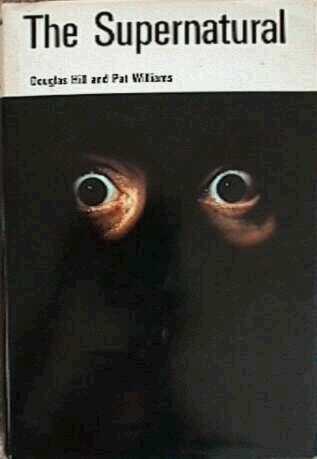 |
Hill, Douglas, and Pat Williams, THE SUPERNATURAL, 2, 1965, Aldus Books
(London), HB. Part of the same lavisly illustrated series that gave
us C. J Jung's MAN AND HIS SYMBOLS, this remains one of the best general
introductions to the world of the supernatural, magic and the occult.
Hill, Douglas, and Pat Williams, THE SUPERNATURAL, 2, 1965, Hawthorn Books (Random House), HB. |
Hughes, Pennethorne, WITCHCRAFT, 2, 1965. Penguin, PB.
Huxley, Aldous, BRAVE NEW WORLD, 1965, Harper and Row, PB. entry.
I CHING, Blofeld, Translation: John, 1, 1965, George Allen and Unwin (British Ed.), HB. See 1968 entry.
Laing, R. D. , DIVIDED SELF, THE, 2, 1965, Penguin, PB. entry
Leary, Timothy, Ralph Metzner, and Gunther M. Weil, eds., THE
PSYCHEDELIC READER, 1, 1965, University Books, H B. Articles from the first
4 issues of the PYSCHEDELIC REVIEW. Essential counterculture reading.
See PSYCHEDELIC REVIEW, 1967 entry.
 |
Lovecraft, HP, THE CASE OF CHARLES DEXTER WARD, 1965, Belmont, PB. Reprint of Lovecraft's THE STRANGE CASE OF CHARLES DEXTER WARD (see HAUNTED PALACE, 1963 entry, and Lovecraft, 1971 entry). |
 |
Margulies, Leo, ed., WORLDS OF WEIRD, 1, 1965, Pyramid, PB. More supernatural thrillers from WEIRD TALES Magazine. (See Margulies, 1964 entry). |
| Miller, Henry, THE ROSY CRUCIFIXON: Greenleaf Classics, a publisher of porn and sex titles Got the jump on Grove Press and issued the text of the Olympia Press, Paris, 1957 edition. This forced Grove Press to rush their own paperback edition into production before the hardback edition. |
|
| Miller, Henry, THE ROSY CRUCIFIXON: As noted above the first authorized editons of Miller's trilogy are the Black Cat paperbacks, and not the Grove Press bound editions as is often stated. Miller was not happy about the unauthorized editions. He got no royalties from them. |
|
| Miller, Henry, THE ROSY CRUCIFIXON:
|
|
McLuhan, Marshall, UNDERSTANDING MEDIA: THE EXTENSIONS OF MAN, 2, 1965, McGraw Hill, PB. New introduction and bibliography. Also Signet ed. 1966?
McMahan, Basil B., MYSTERY OF THE OLD STONE FORT, THE, 1965, Nashville Book Co., HB.
Mowat, Farley, WESTVIKING, 1965, Little Brown, HB. Need Copy and info.
Oldenbourg, Zoe, DESTINY OF FIRE, 2, 1965, Ballantine, PB, Entry
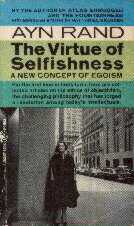 |
Rand, Ayn with Branden, Nathaniel, VIRTUE OF SELFISHNESS, THE, 2, 1965, Signet, PB. These are articles originally published by THE OBJECTIVIST NEWSLETTER (later THE OBJECTIVIST). About a forth of the essays are by OBJECTIVIST editor Nathaniel Branden, who would later become a major force in "me generation" pop psychology (see 1971 entry). This volume is an attack on Rand's eternal philosophical villain, altruism. Rand's "selfishness" means acting from self-interest, not to be confused with "greed" or "hedonism." There is little doubt that a lot of greedy and self-centered folk found justification in "objectivism" (several essays address this problem). It is interesting to read as most of the essays are engaged in a refinement of the growing school of thought. |
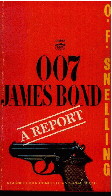 |
Snelling, O. F., JAMES BOND: A REPORT, 1, 1965, Signet, PB. Reprint of 1964 British title. The first of man "fictional biographies" of James Bond and other pop and pulp heroes. (See Amis, 1965 & 1966 entries). |
 |
Southern, Terry, and Mason Hoffenberg, CANDY, 2, 1965, Putnam, PB. This is the paperback edition of the satiric classic which was all over the place in 1965. The number of pirated and unauthorized editions of the work are to numerous to list, but at least one is worthy of mention. Porn publisher Brandon House and mainstream publisher Dell Books co-published an edition based on the original Olympia Press edition, which makes it a rather unusual and odd moment in publishing. |
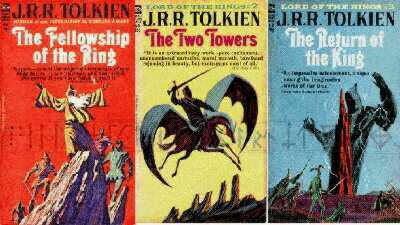 |
| Tolkien, J.R.R., LORD OF THE RINGS (3 Vols.), 1, 1965, Ace Books, June, PB. The "unauthorized edition" published by Ace is the true first paperback edition of the trilogy in the USA. Ace claimed that the trilogy's copyrite had lapsed and it was in public domain. Lawsuits followed quickly. |
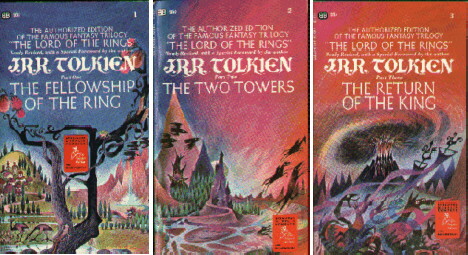 |
| Tolkien, J.R.R., LORD OF THE RINGS (3 Vols.), 1, 1965, Ballantine, Books, October, PB. "Authorized Edition." These volumes were published in 1954 and 1955 by George Allen and Unwin in Britain, and Houghton Mifflin in the U.S. It's a long fantasy epic, with allegorical overtones, set in a world full of mythical beasts and monsters. The basic structure is the quest for an artifact of ambiguous power, whose effect on its holder is often evil. I use that generic language to emphasize the structure, because this structure would become a major and well-loved theme in fantasy and occult fiction in the years to come. It's the archetypal structure that's exciting enough to drive the reader forward through all three volumes. It's certainly not Tolkien's stuffy long-winded style that drives the reader the distance (see O'Neill, INDIVIDUATED HOBBIT, 1979 entry). |
TWILIGHT ZONE, THE, T.V. Show, 1965, Last episode 5 Sept 65.
Vallee, Jacques, ANATOMY OF A PHENOMENON, 1, 1965, Henry Regnery, HB. See 1966 entry.
Velikovsky, Immanuel, WORLDS IN COLLISION, 2, 1965, Delta, Trade.
Viereck, Peter, METAPOLITICS, 1, 1965, Capricorn, PB. This is a revision of Viereck's 1941 work on the philosophical roots of Nazism. The book had a brisk life in colleges and universities. Viereck pointed out that Nazism owed much to romanticism and mysticism. As he pointed out in his introduction, the book really didn't come into its own until the 60's. For years the philosophical and religio-mystical elements of Nazism had been dismissed as mere crack-pottery. Viereck showed clearly that they were part of a long well-defined European tradition. I believe that V. and MORNING OF THE MAGICIANS had a major part in taking the lid off of this subject (see introduction).
Watts, Alan, JOYOUS COSMOLOGY, THE, 2, 1965, Vintage, Trade. With forward by Timothy Leary and Richard Alpert.
White, T.H., ONCE AND FUTURE KING, THE, 1, 1965, Putnam, HB. This book is actually four novels that White had been publishing since 1939. Funny, whimsical, sad, and tragic, it presents the characters of the Arthurian romances in very human terms. White is the founder of the "revisionist" school of Arthurian romances, where the tales are retold in a new light for modern audiences. The musical comedy CAMELOT and the film version of it made White's books extremely popular. There's little doubt in my mind that White's books sparked the massive Arthurian revival of the 60's and 70's.
Whitten, Leslie, PROGENY OF THE ADDER, 1965, Doubleday, HB. PB? Ace?
1966?
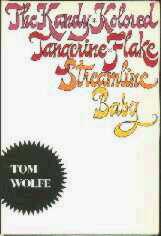 |
Wolfe, Tom, THE KANDY-KOLORED TANGERINE-FLAKE STREAMLINE BABY, 1, 1965 New York, Farrar, Straus & Giroux, HB. Wolfe's first book is a collection of essays written for new papers and some of his line drawings. |
 Back
to Absolute Elsewhere Contents.
Back
to Absolute Elsewhere Contents.